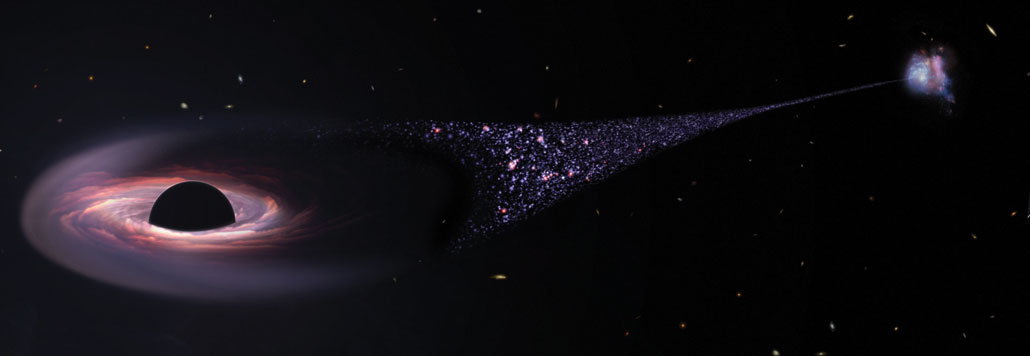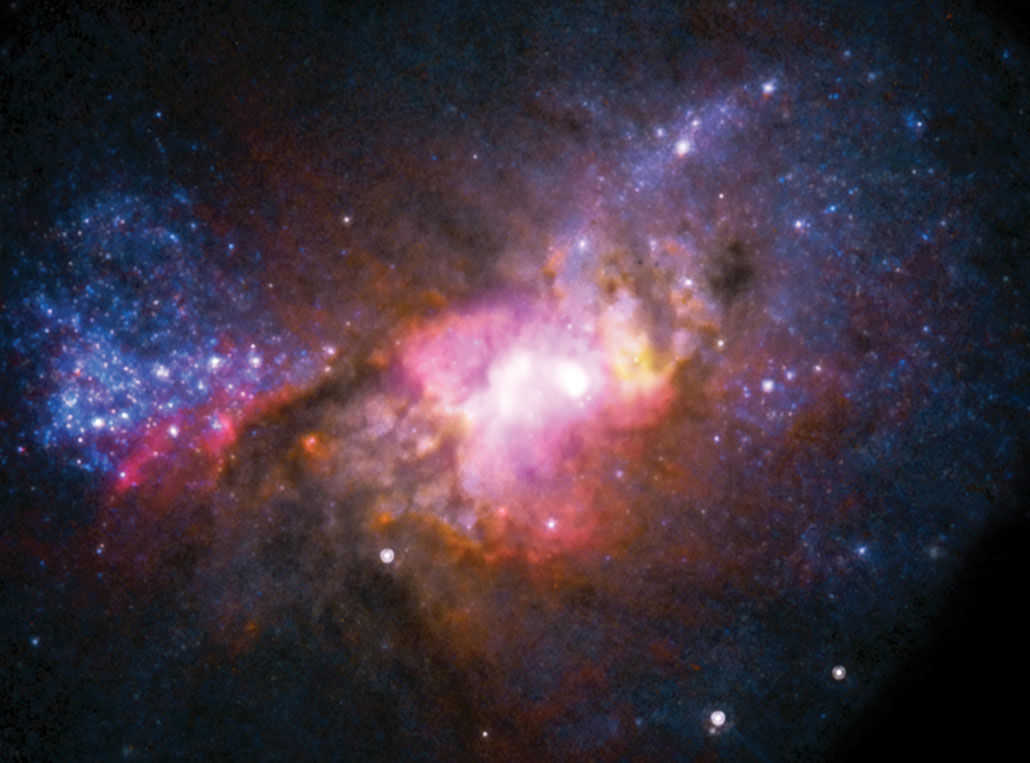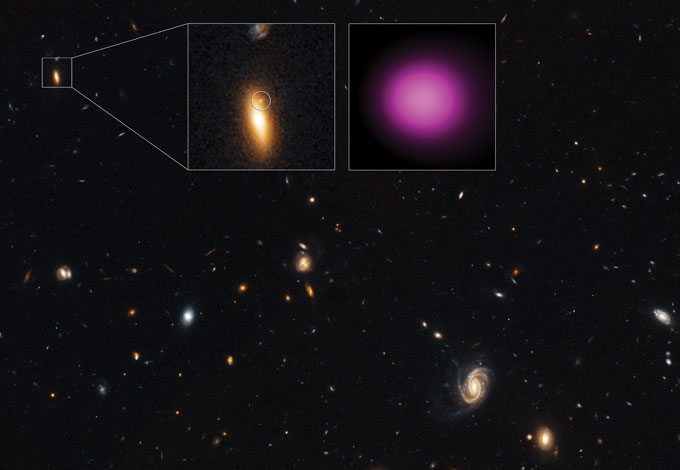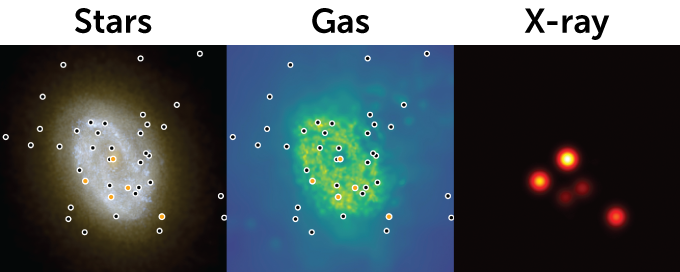Weird black holes may hold secrets of the early universe
Growing evidence suggests that rogue black holes and other eccentric behemoths exist

Big black holes may not always reside in the hearts of massive galaxies. Recent observations and computer simulations suggest that some are found at the centers of dwarf galaxies.
Alfred Pasieka/Science Photo Library/Getty Images Plus
Our galaxy’s heart is a gluttonous monster. Like the mythical Kammapa of the Sotho people of southern Africa, the Milky Way’s central, supermassive black hole has swallowed nearly everything around it, growing heftier and heftier the more it eats. And it’s not alone. Black holes weighing as much as thousands, millions or even billions of suns sit at the center of nearly all known massive galaxies.
For decades, scientists thought that was the only place they’d find such behemoths, because only massive galaxies had enough material to feed the monsters’ excessive appetites. But beginning about two decades ago, computer simulations of the earliest black holes started turning up oddities — big black holes that weren’t smack-dab where they were expected. These misfits must be nothing more than flukes, many scientists reasoned at the time, dismissing the results without a second thought.
But others weren’t so certain the oddballs should be cast off. If observations show that these unusual black holes exist in the nearby universe, these astrophysicists speculated, they could be untapped clues to the universe’s infancy and adolescence.
“We can, weirdly, [learn about] the super-beginning of the universe by looking at things really close to us,” says theoretical astrophysicist Jillian Bellovary of Queensborough Community College in New York City.
The notion remained just an idea for years. But now, the existence of these misfits isn’t so easy to ignore. Astronomers have turned up signs of a number of unexpectedly massive black holes in the universe’s tiniest galaxies, and surprisingly, some of those black holes don’t appear to sit at their galaxies’ centers. Even more intriguing, astronomers have spotted evidence of black holes wandering at their galaxies’ edges, and in rare cases, being kicked from their homes into intergalactic space.
Perhaps these black holes aren’t merely cosmic nonconformists but instead big players in the story of our universe. If so, they are a tool for probing one of the greatest mysteries in all of astrophysics — how the cosmic Kammapas we see today came to be.
“Without understanding what black holes are doing, you cannot understand galaxy evolution,” says Xiaohui Fan, a cosmologist at the University of Arizona in Tucson, making it impossible to explain the landscape of the universe.

Little galaxies can have big black holes
Our current cosmological understanding of how black holes got so big goes something like this: As galaxies grow, collide and merge over cosmic time, they take on gobs of new stars, gas and dust. The black holes at the galaxies’ centers grow in lockstep, ballooning as they merge with one another and feed on the newly acquired material. A rough estimate puts a supermassive black hole’s heft at somewhere around a thousandth of the mass of its home galaxy.
In this scenario, the universe’s littlest galaxies, called dwarf galaxies, probably didn’t go through many mergers in the past. Tipping the scales at only about a millionth the mass of the Milky Way, they should have relatively runty black holes, or none at all.
But in the late 2000s, astrophysicist Marta Volonteri of Institut d’Astrophysique de Paris at Sorbonne University helped run computer simulations that tracked the evolution of massive black holes from birth to today. In those efforts, almost as soon as they popped into existence, even the smallest galaxies could have surprisingly large black holes. As time passed, some of those galaxies never grew or merged with others, leaving them unmarred after billions of years of cosmic evolution.
A wild idea occurred to Volonteri and her colleagues: These galaxies and their black holes were relics of the universe’s birth. If massive black holes in dwarf galaxies did exist, and if astronomers could find them, those black holes would be an unprecedented window into how the first black holes formed.
The first hints that they do exist came from a serendipitous find by astronomer Amy Reines. More than a decade ago, she was in graduate school at the University of Virginia in Charlottesville poring through telescope data on a dwarf galaxy 30 million light-years from Earth. It was bursting with stars, and Reines was trying to learn more about how these balls of hot gas are born.
Initially Reines looked at data from the galaxy, called Henize 2-10, in radio and near-infrared wavelengths of light. She spotted a cosmic baby rattle, a roughly 300-light-year-long bridge of gas connecting two dusty balls swaddling newly coalescing stars. A deeper dive into the data revealed extreme radio emissions right in the middle of the rattle, along with bright X-rays coming from the same spot, inklings of a huge black hole with a mass of a million suns.

“I hadn’t seen this before,” says Reines, now at Montana State University in Bozeman. Dwarf galaxies, she too had assumed, shouldn’t have big black holes. She remained skeptical of her interpretation until a few months later when she attended a talk in Seattle at the 2011 American Astronomical Society meeting.
It was there that Bellovary, then a postdoctoral researcher at the University of Michigan in Ann Arbor and collaborating with Volonteri, presented new simulations of galaxy formation. Bellovary described the formation of galaxies with a range of masses and histories, and discussed how the results could make predictions about how massive black holes are scattered throughout the universe.
Like Volonteri’s earlier work, Bellovary’s simulations suggested that big galaxies were not the only ones to harbor big black holes; scrawny galaxies could have them too.
In a session at the same meeting, Reines highlighted her discovery of dwarf galaxy Henize 2-10 and its uncharacteristically massive black hole. Like two black holes circling each other and then colliding, unexpected computer simulations met unexpected real-world observations.
The combined work suggested that not only do massive galaxies have big black holes, but maybe a majority of galaxies do too, Fan says. And that raised a lot of new questions about how black holes and galaxies grow up together.
After hearing Bellovary’s talk and publishing her own findings, Reines shifted her research focus from the birth of stars to finding big black holes. The behemoths pulled her in. She launched an effort to search for them in dwarf galaxies. Like other astronomers, she decided to scan the skies for the rings of cosmic crumbs that burn brightly around feeding black holes at the centers of galaxies — active galactic nuclei. That’s where black holes should be, she assumed. “I mean, it’s in the name, active galactic nuclei,” she explains.
Reines combed through data from the Sloan Digital Sky Survey looking for the visible-light signatures of central black holes. Of the roughly 25,000 dwarf galaxies in her analysis, 151 of them appeared to harbor a big black hole, she and colleagues reported in 2013.
Volonteri says she was elated by the results. They validated her wild idea that dwarf galaxies could have really big black holes, and possibly that those black holes could tell us something about the very first black holes.
A key clue may be in the masses of dwarf galaxies’ black holes. The two leading ideas for how the first black holes formed create black holes of different masses. One idea supposes that these black holes formed from the implosion of the first stars and would tend to be relatively lightweight. The other idea suggests that the first black holes formed from the direct collapse of giant gas clouds and would be heavier. If the gas cloud idea is correct, it could explain another cosmic puzzle: how black holes in the early universe got so big so fast. “We observe them, and they are already huge,” Bellovary says. If the history of the universe was displayed on a clock, these monsters would have mere seconds to form, she explains.
If big black holes in dwarf galaxies are indeed ancient relics from the early universe, their masses should be akin to the masses of the first black holes. If so, they could help explain how the seeds of some of the heftiest black holes we see today formed.
According to a recent estimate, the black hole in Henize 2-10 tips the scales at a few million suns (SN: 9/11/21, p. 12). That’s a data point in favor of the direct cloud collapse idea, but it’s just one measurement with a lot of assumptions. For now, measuring black holes’ masses is no easy task.
Wandering black holes may offer cosmic clues
Fortunately, there’s another way to get a clue to the masses of early black holes. It relies heavily on another type of oddball — big black holes that don’t sit exactly at the center of dwarf galaxies.
When Bellovary shared her simulations back in 2011, the idea of big black holes in scrawny galaxies wasn’t the only surprise. Her work also predicted that some Kammapas would be off-kilter from their galactic centers, wandering around the dwarfs’ edges after failing to fall to their cores.
“I always like to think about the outliers, or the weird little rejects, or the nonconformists,” Bellovary says. She chose to rerun her simulations, zooming in on the littlest galaxies. When she did, she found that half of the massive black holes in dwarf galaxies should be off-center, she reported in early 2019 in Monthly Notices of the Royal Astronomical Society.
As if on cue, Reines came in a few months later with observations that bolstered Bellovary’s simulations. Using the Very Large Array of radio telescopes in New Mexico, Reines and colleagues had peered at emissions coming from 111 dwarf galaxies, 13 of which most likely had big black holes. Of those 13 big black holes, a few appeared to sit off-center from their galaxies’ cores (SN: 6/22/19, p. 12).
Finding wanderers was a jackpot. “Once a black hole starts wandering, it does not grow in mass anymore,” Volonteri says. The lowest-mass wanderers should roughly match the initial mass of the very first black holes, making them a good proxy for the seeds that would later grow into supermassive black holes.
Unfortunately, the mass of wanderers is even harder to figure out than the mass of Kammapas sitting at their galaxies’ cores. Researchers are instead turning to these wanderers’ overall numbers for clues. If the earliest black holes — the seeds of today’s supermassive black holes — formed from the direct collapse of huge gas clouds flowing into galaxies, then wanderers shouldn’t be very common in dwarf galaxies. That’s because converting a gas cloud’s mass into a massive black hole is difficult and thus expected to be a rare phenomenon, Volonteri explains. An easier way to form early black holes — through the implosion of the first stars — would result in many more wanderers.
Another possible scenario that scientists are now considering is whether mergers of early stars or black holes in dense galaxy cores could have made the seeds of supermassive black holes. That process would also result in a lot of wanderers. But these black holes would be somewhat more massive than black holes formed from stellar implosions.
Because signs of wanderers keep popping up, researchers are leaning away from the direct collapse idea. But to truly get a better sense of how big black holes formed, researchers need to census wandering black holes not only in the nearby universe but also further back in time, says Angelo Ricarte of the Harvard-Smithsonian Center for Astrophysics in Cambridge, Mass. We need to know if what’s happening now is similar to what happened then, because the environment in the early universe was very different.
“I always like to think about the outliers, or the weird little rejects, or the nonconformists.”
Jillian Bellovary
Are rogue black holes real?
Massive galaxies appear to have wanderers too, some that are flying across their host galaxies at 10 times the speed of wanderers in dwarf galaxies.
But scientists aren’t entirely sure if these black holes gone rogue are real. When one turned up in 2003 in Volonteri’s simulations, scientists blew it off. The rogues showed up again in Bellovary’s simulations. The reaction? Skepticism. And that skepticism remained even when astronomers announced bright, flashy X-ray signals coming from candidate rogues.
Several years ago, a Hubble Space Telescope image and data from other observatories offered evidence of a black hole with a billion suns’ worth of mass getting booted to the edge of its galaxy (SN: 4/29/17, p. 16). And earlier this year, images from Hubble and the Keck Observatory revealed the possibility of a trifecta of supermassive black holes interacting, with one given so much oomph that it’s been ejected to intergalactic space (SN: 4/8/23, p. 11). But a separate team proposes that what some scientists are calling a rogue black hole might instead be a galaxy viewed edge on.

Volonteri continues to track each candidate rogue, along with other oddball black holes astronomers have put forward. They all somehow have to fit into our full understanding of the history of supermassive black holes, she says. And once again, how often they show up in observations could provide clues to the fuller picture.
If observations show that slow-moving wanderers are abundant, then collisions and mergers of really big black holes are presumably rare. Slow-moving wanderers haven’t interacted with other black holes and so haven’t picked up extra zing relative to the stars around them. The story the universe would be telling us is that the supermassive black holes we see today didn’t grow through repeated mergers after all. But, Volonteri says, if there are a lot of supermassive black holes being shot from the centers of their galaxies to the distant edges, black hole interactions, including mergers, must be common.
With a few dozen candidate oddballs in dwarf galaxies and only a few far-flung rogue candidates identified, the picture is not yet clear. What we do know, Fan explains, is that understanding cosmic evolution requires a good sense of the birth and evolution of the “dark sector” of galaxies — including black holes.
More observational evidence of oddballs would help, and more astronomers have joined the search. In 2021, a team including Reines and Mallory Molina of the University of Utah in Salt Lake City reported a new way to spot signs of massive black holes in dwarfs, specifically if the behemoths are feeding on gas and dust. The technique searches dwarfs for a red glow given off by an unusual type of iron. And a team from Dartmouth reported last year that very-high-energy X-rays may also reveal obscure behemoths.
Future observatories may aid in the hunt too. The Vera C. Rubin Observatory, located in Chile and slated to turn on next year, can sweep the skies looking for wanderers. And the next-generation Very Large Array, a proposed radio observatory, will be sensitive enough to spot signs of black holes in dwarf galaxies.
With the goal of detecting collisions of very massive black holes, the Laser Interferometer Space Antenna, or LISA, and the proposed Einstein Telescope may one day offer clues to how common cataclysmic black hole interactions are and have been.
Time and new technology will tell. For now, oddball black holes spark our imagination, prompting us to ask big questions and uncover new evidence in the pursuit of a deeper understanding of cosmic history. With each purported discovery, you can’t help but wonder: What else is hidden out there? Perhaps there are other oddities not yet discovered that could tie us to the earliest universe, Bellovary says, and reveal our cosmic origins. But only if we’re willing to chase the misfits and their stories.








